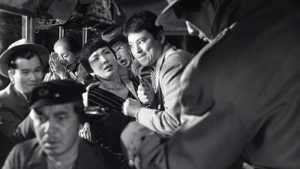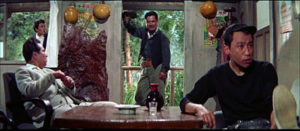STUDIO: Arrow | DIRECTOR: Seijun Suzuki | CAST: Keiko Shima, Hiroyuki Nagato, Yuji Kodaka, Koji Wada, Hideaka Nitani
RELEASE DATE: 4/17/18 | PRICE: Blu-ray/DVD Combo $43.99
BONUSES: Audio commentary by critic and author Jasper Sharp, interview with film historian Tony Rayns, limited edition booklet
SPECS: NR | 423 min. | Crime drama | 2.35:1 widescreen | mono | Japanese with English subtitles
The first volume of early Seijun Suzuki (Branded To Kill, Tokyo Drifter) films from Arrow Films was comprised of melodramas that showed the filmmaker’s characteristically subversive techniques creeping into his work. The five films in that set were all melodramas; this second volume contains five beautifully restored crime films that prefigured his best-known films of the Sixties.
The quintet of pictures included in Seijun Suzuki: The Early Years. Vol. 2 have never been commercially available in the U.S. and have only ever been seen here in a retrospective that toured repertory houses in 2015. Interestingly, the films do not contain many of the visual flourishes that Suzuki is best known for (jarring editing, oblique framing, intentionally artificial set design).
Instead, these B-features demonstrate his complete mastery of the noir approach, from visual tropes familiar from American and French noirs to straightforward, subtly cynical views of human behavior.
The earliest film, Eight Hours of Terror (1957), is a tightly constructed thriller about a bus to Tokyo containing a disparate group of passengers (each designated by his or her class status) who are confronted by two homicidal crooks. It’s an extremely well-written piece that, despite some corny elements, shows that Suzuki could craft a perfectly “normal” thriller in the manner of his contemporaries.
In The Sleeping Beast Within (1960) an executive about to retire disappears, and his daughter and her reporter boyfriend begin to hunt for him. When he suddenly reappears, the reporter realizes that the executive has become involved in drug smuggling. The film’s finale is Suzuki’s most specific homage to American film noir, as the explosive conclusion to Kiss Me Deadly is recreated.
Smashing the O-Line (1960) is very similar to Beast Within, in that it depicts a Japan where reporters are more honest and better crimefighters than the police. In this instance, two reporters set out to bust a drug-smuggling ring from Hong Kong that is infiltrating Japan.
Tokyo Knights (1961) is an over-the-top affair that runs through several different plot elements in one sleek B-movie package. The hero is a rebellious student who has an astounding (and ridiculous) number of talents — in addition to being an expert in every sport from rugby to martial arts, he is also a talented bebop musician and actor-dancer in Noh plays(!).
Like all of the leads in Suzuki’s early films, he discovers and eliminates the villains rather handily. The filmmaker began to “fragment” his storylines in the Sixties, and that is indicated here by a few stray images, including a question mark-shaped dissolve.
Man with a Shotgun (1961) is a Suzuki “Eastern,” with many familiar Western motifs used in a Japanese setting. A wandering hero looking for the men who killed his wife discovers them in a town where a lumbermill is the main source of employment. The film is a gorgeous-looking riff on Westerns, with showdowns, bar fights and noble deeds performed by the ultra-noble protagonist.
There are two supplements included on the two discs in this package. The first is an audio commentary by writer Jason Sharp for Smashing the O-Line. He demonstrates a very thorough knowledge of the performers in the films and of Nikkatsu, Suzuki’s studio during this period. He situates O-Line as a sort of unofficial follow-up to Beast Within and amusingly resorts to UK slang by deeming one villain “a real rotter.”
The second supplement is a continuation of the interview with film historian Tony Rayns, which began in the first early Suzuki collection from Arrow. Rayns is just as honest here about the films, admitting that none “are cast-iron classics” but four of the five are “defensible” (he is rather harsh about the delightfully crazy Tokyo Knights).
Rayns discusses the five films as they relate to the “Diamond Line” at Nikkatsu. The “Line” was a group of young actors who were showcased by the studio in vehicles like these crime dramas.
Most interesting is Rayns’ discussion of “borderlessness” in the films. This refers to the fact that Suzuki and other Japanese filmmakers of the time were “freely importing ideas from foreign genre movies.” Thus, characters dress in the western fashion, listen to jazz and fight to prevent drugs from being smuggled into Japan — a situation that Rayns notes was not a problem at all in the period these films were made.
|
Buy or Rent Seijun Suzuki: The Early Years. Vol. 2. Border Crossings: The Crime and Action Movies
|
|---|


Leave a Reply